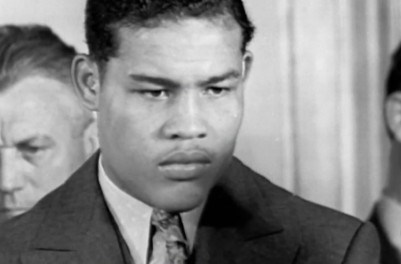After Jim Braddock demystified the frightening power of Max Baer on June 13, 1935, it drove the heavyweight division into an unexpected state of flux. Braddock’s inspired 15-round upset decision over the long-armed 6-foot-4 Baer lifted the crown and also created a sense of anticipation that hadn’t existed before.
Prior to the upset by Braddock, the general thought was that the destructive Baer would reign as champ for many years to come. Baer was seen as head and shoulders above the rest of the contenders and pretenders.
Braddock’s shocking victory changed people’s perspectives.
An article in the Chicago Tribune dated June 20, a week after Braddock’s triumph, includes the name of Joe Louis in a short list of legitimate contenders for Braddock’s crown. The others on the list were all former champions: Baer, Max Schmeling and Primo Carnera. This was just a week before Louis and Carnera were scheduled to meet at Yankee Stadium in what would be Louis’s New York debut.
Louis was still very young, but he had a reputation. He had been the Golden Gloves champion of 1934 and had set aside every opponent in his path as a professional, mostly by KO. As the unnamed writer of the article in the Tribune goes on to say, “Joe, who has been termed the Brown Bomber, is a newcomer to the top, out of the amateur ranks only a year. Eighteen knockouts out of twenty-two opponents … show a punch, and punches are what fight crowds like. They are what earned him this chance …”
From the time that Louis, the knockout sensation from the Midwest, was “made” with ex-champ Carnera, the public interest was huge. And the interest only intensified after Braddock’s shocking victory over Baer. A crowd of 80,000 was expected at Yankee Stadium – including tens of thousands of African-Americans from Harlem — to see how the young Louis would fare against the much more experienced and much bigger Carnera.
In the same June 20 issue of the Tribune, there was a report from Carnera’s training headquarters in Owasco Lake, N.Y. A “superbly conditioned” Carnera, the report said, “went through eight tough rounds of sparring” without breathing hard.
Unfortunately, one of Carnera’s sparring partners was a decent heavyweight from Washington named Natie Brown, who went 10 hard rounds with Louis on March 29 at Detroit’s old Olympia Stadium. Brown was much quicker than Carnera and “slapped” the former champ around, according to the Tribune reporter.
Brown “caused consternation to Carnera’s handlers by the ease with which he pounded the huge Italian.”
Carnera himself was undisturbed, however. When interviewed by the Tribune’s famed sportswriter Wilfred Smith just two days before the bout with Louis, Carnera expressed supreme confidence.
Carnera was “sitting at a bar adjacent to the roller skating rink” and “gurgling a bottle of ale” at the resort in Owasco Lake where he was training when Smith interviewed him.
“This Louis, he’s a keed,” Primo said with a wide, toothy smile in his own brand of broken English. “Who he fight? Knock out Da Preem, ho, ho! I pusha the feest like this. Fifteen rounds I push. Twenty if permit, and no tired. Then I win.”
Of course, as the history books tell us and the ring records verify, things did not go quite as Da Preem planned on the night of June 25, 1935 in Yankee Stadium.
Louis was every bit as lethal as advertised and was simply too skilled and too fast for the muscular but awkward Carnera.
Louis discovered early in the bout that he would not be able to effectively reach the taller Carnera’s head with blows until he had invested in a body attack.
Carnera, who came into the ring with an 83-7 record and weighing 260 pounds, 65 pounds more than Joe, had only one weapon that caused Louis any difficulty at all. Carnera’s jab didn’t hurt Joe but kept him off stride at times as Louis stalked the bigger man.
“The way he kept coming back with that jabbing left puzzled me, so I didn’t feel sure (when I would knock him out),” Louis told reporters after the fight.
According to the ringside report of Harvey Woodruff, Louis used a two-fisted body attack in the second, third and fourth rounds to systematically lower Carnera’s guard and set up the former champion for a fresh assault to the head in the fifth and sixth rounds.
“Primo, feeling these short blows of tremendous power from either hand, was instinctively and unknowingly lowering his guard more and more,” Woodruff wrote. “His chin now loomed as a target.
“In the fifth and sixth rounds, Louis raised his blows. He not only hooked, but he put body leverage behind his punches. The result was inevitable, even to a man of Carnera’s recuperative power and gameness. It was a humane act when referee Arthur Donovan stopped the encounter.”
Along the way, Louis knocked Carnera down three times in the sixth round. Carnera was “clinging to the ropes” and bleeding heavily from the mouth when Donovan stepped in at the 2:32 mark.
Immediately after the match, promoter Mike Jacobs announced that Louis would face still another former champion, Max Baer, in the fall at one of the New York ball parks.
For Louis, the bout with Baer would be another big step on the path that would eventually lead to a title shot against Braddock in June of 1937.
A stunning defeat at the hands of Max Schmeling in June of 1936 at Yankee Stadium temporarily derailed the championship express of the Brown Bomber. Louis would eventually turn the tables, however. Louis was always better the second time around.
Mike Dunn is a writer and boxing historian living in Lake City, Mich.
